Hospice, Caregiving, and Education Programs
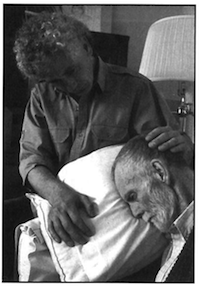
Hospice services aim to improve the quality of life during the dying process. A hospice team usually consists of a physician, a nurse, and a social worker or volunteer, who may be a spiritual caregiver. To locate hospice programs in your area, or for general information about hospice care as well as volunteer work and training, contact the National Hospice Organization, 1901 North Moore Street, Suite 901, Arlington, Virginia 22209; (703) 243-5900.
Many hospice programs, including Buddhist-related ones, coordinate with caregivers from visiting nurse associations (VNAs). These associations also offer comprehensive services tailored to meet the individual needs of each patient. VNA branches are located across the country; to find the one nearest you, call the Visiting Nurses Association of America at (800) 426-2547.
These organizations and local Buddhist centers also may be able to refer you to hospital-based palliative care programs or spiritual care programs for the dying.
Zen Hospice Project
273 Page Street
San Francisco, California 94102
(415) 863-2910
www.zenhospice.org
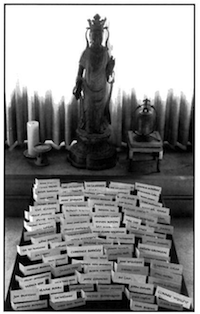
The Zen Hospice Project provides practical, emotional, and spiritual support to over 200 AIDS and cancer patients annually at Laguna Honda Hospital and its fourbed Zen Hospice Project Guest House. The Project began in 1987 as part of San Francisco Zen Center (SFZC) and remains under the guidance of its founding director, Frank Ostaseski, though it is now separate from SFZC.
In addition to providing services for clients at all stages of illness and education for the general public, the dying, and health care professionals, this organization offers consulting services for developing hospice programs.
Upaya: The Project on Being with Dying
1404 Cerro Gordo Road
Santa Fe, New Mexico 87501 (505) 986-8518
www.rt.66./com/-upaya
The Project on Being with Dying is a training and support program for health care professionals, people with severe illnesses, and others who are working with issues of death and dying. Founded by Buddhist teacher Joan Halifax in 1994, the Project offers professional training programs, educational materials, contemplative retreats, and a local Santa Fe program—called the Partners’ Program—for caregivers who want to incorporate contemplative perspectives and practices in working with the dying.
The Project also consults with many centers and individuals around the country on spiritually assisted dying. Contact Upaya for more information about Project volunteers or programs in your area.
Maitri: Residential Care for People Living with AIDS
401 Duboce Avenue
San Francisco, California 94117
(415) 863-8508
Founded by the late Zen priest Issan Dorsey, this ten-year-old hospice program is Buddhist in origin, philosophy, and name, though it is no longer affiliated with the Hartford Street Zen Center. In addition to hospice care, Maitri’s newly designed program also provides residential care for people with AIDS.
Living/Dying Project
P.O.Box 357
Fairfax, California 94978
(415) 456-3915
www.weel.com/user/dborglum
Living/Dying Project, under the direction of Dale Borglum, aims to help people approach death without fear and incorporates compassion and awareness into the dying process. Through the Project’s Open Circle program, clients at all stages of illness are matched with trained volunteers who meet with them on an ongoing basis.
Rigpa Fellowship: Spiritual Care Education and Training Program
449 Powell Street, Second Floor
San Francisco, California
94102 (415) 392-2055
www.atlantech.net/rigpa
The Spiritual Care Education and Training Program (SCETP) is a part of the Rigpa Foundation, an international network of Buddhist centers under the spiritual direction of Sogyal Rinpoche, author of The Tibetan Book of Living and Dying. SCETP, launched in 1994, provides professional caregivers and trained volunteers with education, training, and resources.
SCETP seeks to apply the compassion and wisdom of Buddhist teachings to the needs of the dying and bereaved. Christine Longaker, a senior student of Sogyal Rinpoche and author of Facing Death and Finding Hope, is the program’s principal teacher and advisor.
Naropa Institute
2130 Arapahoe Avenue
Boulder, Colorado 80302
(303) 444-0202
www.naropa.edu
Naropa Institute offers Masters of Arts programs in Gerontology and Long-Term Care Management that train administrators and caregivers who are interested in improving the quality of living and dying of aged people in long term care settings. Naropa’s characteristic contemplative approach to education incorporates basic Buddhist principles with the practical knowledge necessary for effective administration and management skills.
Components of the program include training in mindfulness and body awareness, courses in working with old age and death, courses in administration and management, and a 1,000-hour part-time practical Administrator-inTraining Internship. The program offers two tracks: a gerontology track prepares students for administration and service in long-term care facilities. The long-term care management track licenses students to work as nursing home administrators in Colorado and most other states. Naropa’s Engaged Buddhism Department is currently developing a program for hospice care.
The Natural Death Centre
20 Heber Road
London NW2 6AA, England
011-44- 181-208-2853
www.newciv.org/GIB/
e-mail:rhino@dial.pipex.com
This London-based organization, run by three psychotherapists, offers support programs for people dying at home and their caregivers in Great Britain (its “Befriending Network” links the dying with volunteers who can sit with them or run errands) and aids people in arranging environmentally friendly and do-it-yourself funerals. Its publication s (most of which are available Online) include guides for writing a living will andSooner or Later and Before and After, two books of ideas for improving the quality of dying and for conducting inexpensive and home funerals. The Centre can also help you order a “Chrysalis” willow casket. While its focus is on dying and death in the U.K., the Centre provides information relevant to other countries as well.
IN THE WORKS
Issan House and the Maitri Center: Housing and Health Care for Persons Living with HIV/AIDS
23 Park Avenue
Yonkers, New York 10703
(914) 376-3903
These two Greyston Foundation projects, under the direction of Roshi Bernie Glassman, will open their doors in the fall of 1997. Issan House will provide permanent housing for people living with HIV or AIDS, while the Maitri Day Program will offer adult day care—ranging from medication monitoring and case management, to mental health care, acupuncture, and HIV education
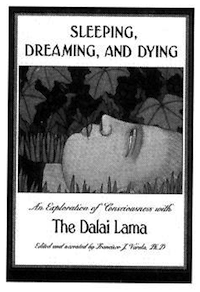
BOOKS
Death and Dharma
Sleeping, Dreaming, and Dying: An Exploration of Consciousness with the Dalai Lama
Edited by Francisco J. Varela, Ph.D.
Wisdom Publications: Boston, 1997.
254 pp., $16.95 (paper).
This is an account of the dialogue between H.H. the Dalai Lama and several Western scientists during the fourth Mind and Life Conference in Dharamsala, India, in 1992. The discussions revolved around the moments of consciousness of sleep, dreams, and death, which neuroscientist Francisco Varela calls the “ego’s shadow zones.” The Dalai Lama and participants continually discovered cross-cultural convergences on the topics of lucid dreaming, near death experiences, and the structure of consciousness.
The Joy of Living and Dying in Peace
H.H. the Dalai Lama
HarperSanFrancisco: San Francisco, 1997.
181 pp., $16.00 (hardcover).
With characteristic clarity, the Dalai Lama explains the importance of a mindful life for a peaceful death in a book that gives the impression of advice from a loving friend. Emphasizing the natural place of death in the life cycle, His Holiness outlines the teachings of the Buddha as the means to accepting the inescapable realities of living and dying and acknowledges the difficulty of achieving right thought and action, citing obstacles from his own life.
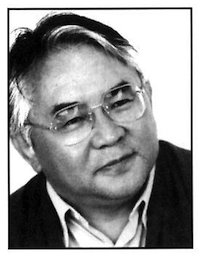
The Tibetan Book of Living and Dying
Sogyal Rinpoche
HarperSanFrancisco: San Francisco, 1993.
425 pp., $16.00 (paper).
In a book that has become a classic manual on living and dying for Buddhists and non-Buddhist s alike, Sogyal Rinpoche offers an accessible guide to meditation practice, the nature of mind, karma and rebirth, teachings on compassion, and care for the dying. The tort is interspersed with anecdotes and excerpts from sources ranging from the Tibetan Book of the Dead to the Christian New Testament.
The Tibetan Book of the Dead: The Great Liberation through Hearing in the Bardo
Translated with commentary by Francesca
Fremantle and Chogyam Trungpa
Shambhala Publications: Boston, 1975.
119 pp., $10.00 (paper).
The Tibetan Book of the Dead: Liberation through Understanding in the Between
Translated by Robert A. F. Thurman
Bantam Books: New York, 1994.
275 pp., $12.95 (paper).
These two excellent translations of the classic Buddhist text contain detailed descriptions of the stages of the bardo thos grol, or in between, along “with commentary and interpretation by the translators. Meant to be read aloud to the recently deceased, this text is a guide for the stages between death and rebirth, with instructions on recognizing the true nature of mind therein. It offers insight into Tibetan concepts of death and the nature of the mind. Each volume contains extensive background information and glossaries.
The Wheel of Life and Death
Philip Kapleau
Doubleday: New York, 1989. 3
70 pp., $12.95 (paper).
Zen teacher Philip Kapleau explores the great and small aspects of preparing for death, from abandoning ego to writing a living will, drawing on the teachings of Buddhism and other spiritual traditions. Much of this classic is written as short anecdotes or answers to students’ questions, with supporting material from Tolstoy to Socrates to Gandhi.
Death, Intermediate State and Rebirth in Tibetan Buddhism
Lati Rinbochay & Jeffrey Hopkins
Snow Lion: Ithaca, New York, 1979.
86 pp., $7.95 (paper).
This is a treatise on Highest Yoga Tantra, which deals with the physiological basis of Buddhist practice. The book explains the practice of purification in the bardos of death, the intermediate state, and rebirth, and offers a guide through these stages, designed to help the practitioner transform his or her own death to benefit others.
Facing Death and Finding Hope
Christine Longaker
Doubleday: New York, 1997.
262 pp., $23.95 (hardcover).
Using her training in Tibetan Buddhism and years of hospice work, Christine Longaker has written a complete spiritual guide for the dying, their families, and caregivers. She outlines “Four Tasks of Living and Dying” as “understanding and transforming suffering; making a connection, healing relationships, and letting go; preparing spiritually for death; and finding meaning in life.”
Longaker recommends meditative and interactive practices to help accomplish those “tasks” and recounts dozens of moving stories of people who have made themselves ready for their deaths, and of those who have survived the deaths of loved ones.
A Year to Live: How to Live This Year As If It Were Your Last
Stephen Levine
Bell Tower: New York, 1997.
175 pp., $20.00 (hardcover).
In his latest book, poet and teacher Stephen Levine suggests how to live as if one were dying, based on his own experiences doing so over the course of a year. Each of us, he recommends, should spend a portion of our lifetime in preparation for death, whether or not we know death is imminent. By doing so, we ready ourselves for death whenever it comes, and rid ourselves in life of unresolved issues. The book includes loosely defined practices inspired by various traditions as well as Levine’s personal experience of his own life and of the death of friends.
Who Dies? An Investigation of Conscious Living and Conscious Dying
Stephen Levine
Doubleday: New York, 1982.
317 pp., $10.95 (paper).
Who Dies? outlines practical approaches to living in anticipation of death, and for accepting and learning from the inevitable when it comes. Levine integrates explanations of the physical, psychological, and spiritual elements of death, building an argument for understanding death as a function of the body and a natural step in the development of awareness. He recommends contemplative and ritual practices and offers personal stories and quotations from classical texts on dying.
Death Is of VitaI Importance: On Life, Death, and Life After Death
Elisabeth Kubler-Ross, M.D.
Station Hill Press:
Barrytown, New York, 1995.
163 pp., $12.95 (paper).
These five essays describe experiences of dying that Kubler-Ross, one of the West’s foremost proponents of “conscious dying,” witnessed in her work and private life. She shares extraordinary stories ranging from a visit to a Nazi concentration camp after World War II to her correspondence with a terminally ill boy who asked “why little children have to die?”
The Troubled Dream of Life: In Search of a Peaceful Death
Daniel Callahan
Simon & Schuster: New York, 1993.
255 pp., $11.00 (paper).
A medical ethics expert, Callahan brings medical, philosophical, and experiential insights to his argument that modern health care and spiritual care are not at odds in allowing for a peaceful death. He takes the emotional comfort of the dying person and medical pragmatism into equal consideration, presenting a balanced guide for those torn between the often opposing influences of spirit and science.
Final Acts of Love: Families, Friends, and Assisted Dying
Stephen Jamison, Ph.D.
G.P. Putnam’s Sons: New York, 1995.
278 pp., $13.95 (paper).
Final Acts of Love presents possibilities and advice for those considering hastening their own deaths, and for the people who care for them. Jamison uses examples of assisted deaths to illustrate the ethical, spiritual, and legal issues entailed, citing the need for “a middle path between what’s legally available and underground technology that only offers release without aesthetics and grace.
Personal Accounts
In the Lap of the Buddha Gavin Harrison
Shambhala Publications: Boston, 1994.
289 pp., $14.00 (paper).
Harrison blends Buddhist teachings and his own experiences as a survivor of childhood sexual abuse and HIV in a memoir of spiritual survival. He also offers meditative practices intended to help readers transform suffering and confront their own fears of death.
Graceful Exits: How Great Beings Die
Sushila Blackman
Weatherhill, Inc.: New York, 1997.
159 pp., $12.95 (paper).
Graceful Exits is a compilation of brief, accessible accounts of the deaths of Tibetan, Hindu, and Zen masters. From Hakuin to Ramakrishna to Kalu Rinpoche, these are enlightened minds on the cusp of profound transformation: unafraid, at peace, and inspiring.
Street Zen: The Life and Work of Issan Dorsey David Schneider
Shambhala Publications: Boston, 1993.
239 pp., $13.00 (paper).
This biography plumbs the life of Issan Dorsey, an American Zen teacher who died of AIDS. Dorsey was a drag queen and substance abuser before discovering—under the influence of LSD—his spiritual path. Much of the text is taken from interviews with Dorsey’s close friends and traces his life from childhood to his becoming abbot of the San Francisco Hartford Street Zen Center and his founding of Maitri Hospice, a hospice center for AIDS patients.
Japanese Death Poems: Written by Zen Monks and Haiku Poets on the Verge of Death
Yoel Hoffmann, Ed.
Charles E. Tuttle Company: Rutland, Vermont, 1986.
366 pp., $21.95 (hardcover).
A wonderful introduction to the Japanese tradition of composing a jisei, or death poem, in the last moments of life, this volume is crammed with exquisite, spontaneous verse and pithy, often hilarious, descriptions of the eccentric and committed monastics who wrote the poems. The book also includes extensive background on Japanese attitudes toward death, and a history of the evolution of death poems.
All of Us: Americans Talk about the Meaning of Death
Patricia Anderson
Delacorte Press: New York, 1996.
364 pp., $22.95 (hardcover).
All of Us may explode the common assumption that ours is a death-denying culture. In interviews with representatives of all sectors of American society, Anderson dug out a startlingly varied collection of attitudes toward, and experiences with, death. These are portraits of concerned, fearful, and questioning minds linked by a common desire to expand their understanding of what it means to die.
Seeing the Crab
Christina Middlebrook
Basic Books: New York, 1996.
212 pp., $22.00 (hardcover).
This is an unflinchingly detailed account of the author’s struggle with breast cancer. Middlebrook writes with impressive clarity on modern medicine and the emotional voyage of illness.
Home Care
Coming Home: A Guide to Dying at Home with Dignity
Deborah Duda
Aurora Press: New York, 1987.
403 pp., $14.95 (paper).
Coming Home is a complete guide to dying at home. It considers every step of this complex process, from making the decision to remain at home to setting up the house for the patient’s needs; from advice on hand ling physical and emotional hardships to untangling legal issues to meeting the spiritual wishes of the dying. Duda offers her personal stories of family members and friends dying at home, making for a compassionate and practical book that opens a window on a traditional way of dying.
Caring for Your Own Dead
Lisa Carlson
Upper Access Publishers: Hinesburg, Vermont, 1987.
343 pp., $17.95 (hardcover).
Carlson has compiled a thoughtful resource for those wishing to handle the funeral arrangements of their loved ones themselves. Caring for someone after his or her death, rather than using impersonal and costly professional services, she argues, can serve as a spiritual catharsis and a final loving gesture toward the deceased. Legal requirements are organized by state, and various options for handling the body—from home vigils to cremation to family burials on private land—are explained, bolstered by Carlson’s personal experiences.
Other
The American Book of the Dead
E.J. Gold
Gateways/IDHHB, Inc. Publishers:
Nevada City, California, 1993.
169 pp., $15.95 (paper).
E. J. Gold offers an accessible interpretation of the Tibetan Book of the Dead. Playful without undermining the seriousness of the original text, The American Book of the Dead is a lively addition to the “humor” department of the Western dharma library.
Dying Well: The Prospect for Growth at the End of Life
Ira Byock, M.D.
Riverhead Books: New York, 1997.
299 pp., $24.95 (hardcover).
A prominent proponent of hospice programs, Byock chronicles the lives and deaths of people in hospice care. The author documents the great boon of spiritual caregiving in helping people die “a good death.”
Gratefulness, the Heart of Prayer
Brother David Steindl-Rast
Paulist Press: New York, 1984.
224 pp., $11.95 (paper)
Steindl-Rast, a Christian contemplative with a deep connection to the Buddha’s teachings, writes from a Christian perspective on mindful living. Death, he teaches, becomes an active experience of life when approached with awareness and a willingness for change.
AUDIO AND VIDEO
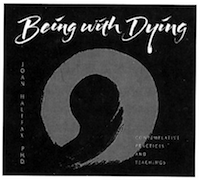
Being with Dying
(audio)
Joan Halifax, Ph.D.
Sounds True, 1997.
$59.95
This set of six audiotapes contains Halifax’s practices for awareness and mindfulness at the time of death. Designed for those caring for the dying, or anyone seeking spiritual insight concerning death, Halifax incorporates meditation, psychology, and philosophy into her program for eliminating fear and anxiety from the dying process.
Break Through Pain
(audio)
Shinzen Young
Sounds True, 1995.
$24.95
Buddhist scholar and biofeedback researcher Young adapts the core principles of mindfulness training to a process that helps manage even extreme chronic pain. Four meditation exercises show how observing and opening to pain can help practitioners stop resisting and “step outside” physical suffering.
Chalice of Repose: A Contemplative Musician’s Approach to Death and Dying with Therese Schroeder-Sheker
(video)
Paul and Jennifer Kaufman.
Sounds True.
$29.95
This video documents the efforts of the Chalice of Repose Project, which uses music to help alleviate the pain of dying. The Project is both an end-of-life care program and a graduate-level school of music-thanatology (music for the care of the dying) created and taught by the musician and medievalist Therese SchroederSheker. Schroeder-Sheker was inspired by medieval monks at the abbey of Cluny, France, who used music and special prayers to care for the dying. This video also chronicles the lives of the musician-clinicians and the patients whose pain has been eased by this work.
The Art of Dying: A Window into the Tibetan Way of Life
(video)
J. Casper Jensen and Majbritt Munck.
Inner Directions.
$29.95
The Art of Dying explores the approach to death as revealed in the ancient Tibetan scriptures and practiced in local customs. A graphic sequence of a sky burial—the offering of a dead body to the living by feeding it to vultures at a charnel ground—provides a unique glimpse into an ancient custom. This video treats dying as part of living, as it explores the sacred culture of Tibet through its landscape, its voices (villagers, monks, and a king from a remote village in Mustang all contribute), and its traditions.
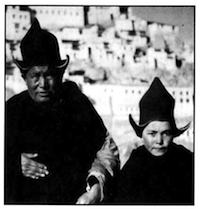
The Tibetan Book of the Dead
(video)
Part I: A Way of Life
Part II: The Great Liberation
by Hiroaki Mori, Yukari Hayashi, and Barrie Angus McLean
Direct Cinema Limited
These tapes, narrated by Leonard Cohen, are a remarkable interpretation of the Tibetan Book of the Dead as it is used in daily life in Ladakh, northern India, and in hospices in Europe and North America. Part One features exquisite footage of the rites and liturgies used for a recently deceased Ladakhi elder, and includes an interview with the Dalai Lama. Part Two interweaves footage of an elderly priest and his young student as they guide the soul of a deceased man into the afterlife. It includes fantastical animation of the migration of the consciousness as it moves from the body to “the in between.”